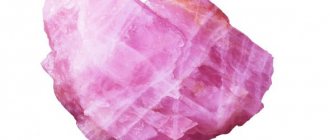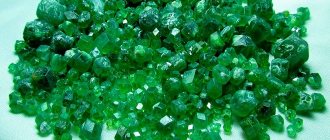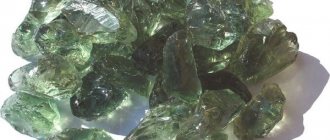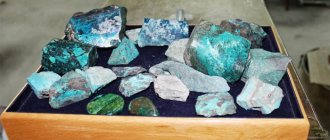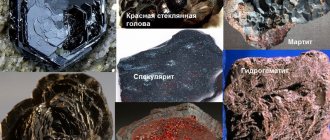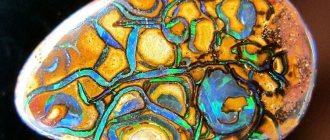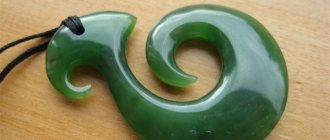This mineral is so diverse that it is simply impossible to confuse it with another gem. There are legends about him in many countries in different parts of the world. Opal can be both a gift and a curse. Not everyone is given the opportunity to find a patron in this gem - the stone will either open up new opportunities for the owner, or bring a person to the very bottom.
Origin story
On all continents of our planet there are ancient legends in which opal played an important role. These stories are fascinating and frightening at the same time.
An interesting legend is preserved by ancient Greek myths that tell of the victory of the god Zeus in the war with the Titans. It is believed that multi-colored opals are divine tears of happiness that fell from heaven to earth. The ancient Greeks were sure that the power of the Zeus stone could endow a person with the gift of clairvoyance.
The Arabs believe in the ability of the mineral to protect from the influence of the elements and bad weather, considering the gem to be a child of lightning. India talks about the goddess of the rainbow, who was pestered by numerous fans. Running away from them, the girl fell, breaking into hundreds of multi-colored stones.
The main purpose of opal for centuries has been to bring good luck. However, history has captured the moments when the nugget became a participant in fateful events. Scandinavians are sure that opal is the creation of the blacksmith god, the material of which was children's eyes. The chronicles of the Middle Ages speak of many dark rituals performed with the help of a gem. In addition, the nugget served as poison - the mineral, crushed into powder, poisoned food.
Do you know that in 1829, after the publication of Walter Scott’s novel “Anna von Geyerstein”, opals ceased to be in demand for the next 20 years. This is due to the plot of the novel, in which the gem causes the death of the owner. A year later, I.V. Kireevsky presented Russia with the story “Opal”, after the publication of which the mineral for a long time acquired a reputation as a stone that brings misfortune.
One of the English monarchs, Edward VII, feared the influence of opal, ordering all the gems to be removed from the crown. Josephine, Napoleon's wife, laughed at this kind of prejudice. However, one day a gem with the beautiful name “Burning Troy” appeared in the house of a married couple, which caused the couple to separate.
Later, a legend appeared that this pebble simply disappeared into thin air. Jewelers had to get rid of stones, since no one wanted to buy jewelry with opals. The interesting thing is that the stone does not have a single meaning.
Translated from three different languages, the name “opal” is interpreted completely differently. In Latin the word means “Enchanting Gaze”, in Greek it means “vision of change”, and in Sanskrit it describes the meaning of “precious stone”.
Australian peoples consider opals to be traces of the Creator of the World, calling the stones “desert fire.” Today, the mineral is the officially recognized symbol of South Australia, as well as the local women's national basketball team.
Story. Legends and myths about the stone
Writers have compared opals to volcanoes, galaxies and fireworks.
Fans and connoisseurs of the stone gave poetic names to unusual opals: “Pandora”, “Light of the World”, “Empress”. In ancient Rome, this gem symbolized love and hope. And it was the Romans who gave the mineral the name we use to this day - “opal”, which meant “precious stone”. Advertising - Continued below
In 75 AD, the Roman scholar Pliny observed: “Some opals carry such a play that they match the deepest and richest colors of artists. Others imitate the blazing fire of burning sulfur and even the bright flashes of burning oil." He was delighted that this kaleidoscopic gemstone included the red of the ruby, the green of the emerald, the yellow of the topaz, the blue of the sapphire and the purple of the amethyst.
The opal was set into the crown of the Roman Emperor Constantine, who claimed that the stone shone in the darkness and believed that it protected his power and his life. In his many stories about opal, he mentioned one wonderful property of this stone, which supposedly allows the owner to become invisible. Naturally, because of this, opal became a talisman for thieves.
For a time it was believed that opal could preserve the life and color of blond hair.
Opal is considered the birthstone of October. And some people think that this stone should not be worn by those born in any other month. But this superstition comes from a novel written in the early 19th century (Walter Scott's Anna Geyerstein), and not from any ancient belief or experience. In fact, for most of history, opal was considered the most fortunate and magical of all gemstones because it can exhibit a play of almost all colors.
Place of Birth
Opal mining is carried out on all continents of the Earth. The deposits are thin layers; large pieces are rare. The main deposit is famous for the Australian mainland, where more than 95% of the world's reserves of the mineral are located.
About 90% of production comes from crystalline white opals. The main excavations are being carried out in the state of South Australia, in the town of Coober Pedy. A type of opal called "boulder" is found in Queensland, mainly at the Janda mine. Only 5% of the total Australian production falls on a rare mineral of different tones of black color. This nugget is mined in the town of Lightning Ridge, which is located in the state of New South Wales.
Did you know that the end of 2008 was marked by news from NASA that opal deposits had been discovered on the planet Mars.
Another large-scale supplier of the mineral is the African country of Ethiopia. Most precious and semi-precious opals are mined in the following countries:
- Australia.
- Mexico.
- Guatemala.
- USA (Nevada).
- Japan.
- Honduras.
- Slovakia.
In the listed mining areas, as well as in Turkey and Kazakhstan, fire and ordinary opals are more common. Minor finds have been found in the Kamchatka region of Russia, as well as in Ukraine.
Opal deposits
Opals occur as thin layers or flat lenses; large specimens are rare.
This stone is very widespread, but most of its deposits (about 97%) are concentrated in Australia, where it is recognized as a national stone. — Advertising —
In addition to Australia, opals are mined in countries such as Ethiopia, Mexico, Brazil, Guatemala, Honduras, Japan, Czech Republic, USA, Russia, and Ukraine.
Physical properties
Opal is an amorphous silica without a crystal lattice, which is capable of impregnating the remains of small animals and vegetation, thereby forming fossils. The mineral fills cracks in the host rocks, forms various sinter forms, and pseudomorphs after other minerals.
This nugget exhibits the effect of opalescence - the internal glow of the stone, scattering on the surface in different colors. White stones are characterized by a radiance of white, red, blue or green colors. Black ones shine with all the colors of the rainbow, and fiery ones have a greenish-brown tint.
The percentage of water in a mineral is responsible for the transparency of the stone. Noble nuggets are always transparent, the water component reaches 13%. Stones with a lower value are considered translucent. There are specimens consisting of 30% water. Opals owe their variety of colors to impurities of various kinds of oxides.
| Property | Description |
| Formula | SiO2 nH2O |
| Impurities | Fe2O3, MgO, CaO |
| Hardness | 5,5 — 6,5 |
| Density | 1.96 - 2.20 g/cm³ |
| Refractive index | 1,44 — 1,46 |
| Kink | Conchoidal. |
| Fragility | Fragile. |
| Cleavage | Absent. |
| Birefringence, dispersion, pleochroism | None. |
| singonia | Amorphous. |
| Shine | Glassy, greasy, waxy, pearlescent, dull. |
| Transparency | From transparent to translucent. |
| Color | White, yellow, red, orange, brown, blue, green, black. |
The mineral is characterized by a glassy luster. Noble samples are famous for their pearlescent luster. The hardness of opal is average, the stone is quite fragile. Another feature is the complete dissolution of the mineral in an alkaline environment.
Also read: Jade – unique capabilities and compatibility with names and zodiac signs
Physical and chemical properties
Blue Universe Opal
Opal is an amorphous form of silica, chemically similar to quartz, but containing on average 3% to 21% water in its mineral structure. Gem-quality opals most often contain between 6% and 10% water.
The chemical formula of the stone is SiO2 nH2O. Composition: silicon dioxide hydrate. The hardness of jewelry opal averages from 5.5 to 6.5 Mohs units. Density - 1.96−2.20 g/cm³.
Jewelry stone is afraid of sudden changes in temperature, strong cooling and heating. In addition, due to the high water content in their composition, opals cannot be kept in places with dry air - sufficient humidity is extremely important for them.
Advertising - Continued below
How are opals formed?
Opal is a sedimentary stone. Under the right conditions, water seeps through the ground, becoming rich in dissolved silicates. When water enters the cavity, it deposits silicates in the form of microscopic spheres, from which opals are subsequently formed.
If the silicate spheres at the base of the opal are the same size and shape and neatly stacked on top of each other, they will scatter light. Such stones are called precious (jewelry) opals. If the spheres of which the mineral is composed are random in size, shape and arrangement, then the resulting opals are ordinary opals that are not capable of demonstrating outstanding optical effects.
Although opal is above average in hardness, it is still brittle and can easily break under enough pressure.
Medicinal properties
During the Middle Ages, when plague epidemics covered Europe, people used opal rings as a protective amulet. Modern lithotherapists describe the healing properties of the stone in the following directions:
- Psychological health. Peruvian blue spherical opal is an ideal choice for meditation or relaxation. This mineral will free a person from the pressure of unnecessary emotions, restore healthy sleep, and relieve anxiety. Any noble nugget will drive away fainting, a feeling of melancholy, and calm the nerves.
- Heart function and other vital functions. Pink opal is suitable for this, it will regulate cardiac activity and improve the functioning of all body functions.
- Vision. Lithotherapists recommend a daily massage of the area between the eyebrows with green opal to improve vision.
- Digestive system. Noble opal can cope with problems of the gastrointestinal tract.
Fire opal will help sluggish, physically weakened people. This stone will fill a person with the necessary vital energy. This type of mineral is also used to treat diseases of the circulatory system, and during periods of depression, fire opal will have a calming effect on a person.
Which zodiac signs does opal suit?
This amazing stone is considered the patron of two zodiac signs:
- Capricorns are recommended to wear a beautiful gem in order to soften certain character traits: uncertainty, tediousness, selfishness, increased anxiety. The magic mineral can relieve the owner from frequent stress and depression. By nature, Capricorn is a zodiac sign characterized by calmness and equanimity. According to these characteristics, it is very similar to opal. However, the peaceful calm of the mineral is strikingly different from the fears of a person hiding behind a mask of equanimity. A suitable opal will help Capricorns compensate for their lack of self-confidence and teach them to open up to loved ones.
- Libras, like opals, are friendly. They do not recognize negativity in relationships between people. But at the same time, the stone, like the representatives of these zodiac signs, symbolizes impermanence. People often suffer from a lack of harmony, the deficiency of which can be compensated by the gem. Libras are characterized by frequent mood swings and an unbalanced character. And opal helps soften these sharp edges and achieve balance. The gem perfectly protects representatives of the sign from going to extremes. It helps to apply mood swings in the creative field.
Of course, the significance of opal stones in astrology is enormous. Any sign can wear these beautiful minerals. In each case, gems will help and protect.
Silver ring with opals (go to the SUNLIGHT catalogue)
Magic properties
From an esoteric point of view, opal is an energetically strong mineral. It is most suitable for people living in a frantic rhythm, striving to reach heights and gain wealth. This is a stone of talent and charisma.
In the hands of a person who lives slowly and measuredly, the gem will turn into a weapon of delayed action - opal will not get along with such an owner, suppressing with its energy, bringing misfortune to the person.
For weak-willed natures, the mineral will become a source of fears and manias; the person will become suspicious and prone to conflicts. But people of creative professions form an ideal tandem with opal - the stone inspires, directs creative endeavors in the right direction, creating a protective barrier around the owner from the influence of others. The magical capabilities of the mineral directly depend on the color variety.
Black opal
This rare variety of mineral is an ideal amulet for people with a strong character and passionate nature. The owner of such a stone will be distinguished by mental acuity and the ability to think analytically.
However, it is worth remembering that such a mineral in combination with gold awakens negative qualities in a person, so black opal is not recommended for people prone to adventurism and gambling. This type of gem is used by sorcerers to perform magical rituals.
White opal
The complete opposite of black mineral. This stone is a symbol of virtue, supporting in the owner such character traits as compassion and patience. The white gem becomes a talisman for healers, philanthropists, and people working in the social sphere.
Blue opal
Minerals of blue and dark blue shades are symbols of good luck. Such an amulet is most suitable for purposeful individuals, as it helps to direct all their energy towards achieving their goals. Dark purple opal awakens the gift of clairvoyance in the owner, and also helps a person become sociable.
Fire opal
The magical abilities of this mineral are different. They depend on who the talisman belongs to - the owner or the owner. For the strong half of humanity, fire opal is a source of male confidence. And representatives of the fair sex will gain femininity, charm, and wisdom.
Pink opal
People who are not prone to fuss and adventure will find the necessary peace, harmony, and security with such a talisman. The pink mineral will create a barrier from diseases and troubles around the owner, help overcome stress, and restore restful sleep, driving away bad dreams. And this gem also acts as an assistant in love affairs.
If a person is prone to melancholy, suicidal feelings, or simply lives in a non-existent world of his fantasies, then the best gift for him would be an opal keychain or pendant set in silver.
It is believed that opal amulets of any shape, be it a figurine or an ordinary processed nugget, protect the house from the influence of natural elements, robbery, and preserve home comfort.
Synthetic opal
Synthetic opal
Artificial opals can be distinguished as a separate type, the production of which has been constantly growing since the beginning of the 20th century. The main types of synthetic stones are:
- Gilson opal was first obtained in 1972 in Switzerland. This is the most expensive artificial type of stone, which is most similar to natural gems, but is distinguished by the complete absence of water and high stability of the material. The formation process of Gilson stones lasts about 18 months.
- Japanese Kyocera opal , obtained on the basis of hydrated silicon oxide, is distinguished by its high aesthetic qualities, therefore the composition of the artificial stone is identical to natural samples. To increase the density and stability of the rock, samples are impregnated with colorless rubber.
- Slocum opal created in 1964 , which is an alloy of sodium-enriched silicon glass and aluminum sparkles that create an iridescent effect.
- In Japan, a plastic imitation has been developed - neo-opal , or pastoral opal.
- In the USA, the production of milky blue opalite - a plastic imitation made of polystyrene, which is coated with acrylic resin, creating the effect of a play of colors inherent in opals. Sometimes samples obtained synthetically are passed off as moonstone.
Jewelry with stone
Opals are used in only one area - the jewelry industry. To enhance the play of colors, stones are given an oval or spherical shape when processed. Minerals of dark shades are more often used to make men's jewelry - rings, bracelets, cufflinks.
Did you know that in 1956, in the state of South Australia, near the city of Coober Pedy, the world's largest opal was found, the value of which today is estimated at 2.5 million Australian dollars.
The main jewelry that is decorated with opal are brooches, pendants, and earrings, since they are least exposed to mechanical stress. Rings with bracelets are less often inlaid with this stone, because they require special care when using.
The cost of jewelry is varied, as is the choice of colors of inserted stone, metal, and product design:
- Earrings. Prices for gold products start at 25,000 rubles. Silver jewelry costs 2–3 times less.
- Rings. From 16,000 rubles for gold jewelry.
- Brooches. 20,000-30,000 rubles for gold products.
- Pendants. From 8000 rubles. Silver – from 2000.
The price of the product depends on the type of stone used to decorate it. Light-colored opals are considered the most affordable.
Read more in another article about jewelry with opal: Read article
Also read: Heliodor - a stone born of the Sun
Reptile from rare opals
Opal is the official stone of South Australia and their national women's basketball team. In the culture of many nations, this mineral is still used as talismans.
The best examples of noble opal are highly valued and are classified as precious stones. The larger the specimen, the higher its cost. Like the famous and impressive Nanius Opal. Its size is larger than a large walnut, and the cost of the stone is approximately five hundred thousand US dollars.
Australian miners in 1909 discovered a small skeleton of a reptile that looked like a snake. The details of the find were completely opalized. And although they stayed in the ground for a long time, they perfectly preserved their integrity. They were replaced with rare opals of amazing color. The unusual find was called the “Opal Snake.” This masterpiece was sold at auction for a decent price to a private collection.
To display the best color play of noble opals, they are given oval or round cabochon shapes. They also use different soft-convex configurations. It all depends on the raw material. In the manufacture of serial products, doublets are often used in the form of polished opal plates glued to obsidian, onyx or black and white glass.
To better preserve the stone, jewelry should be worn more often or stored in low humidity conditions. Thus, the gemstone will gain the necessary moisture from the air or from the owner’s skin. Otherwise, it may become cloudy and crack.
Since opals have low hardness, protective frames are made when creating jewelry. Previously, their surface was treated with oil, and then they began to impregnate the crystals with artificial colorless resin.
High-quality large gemstones are now in fashion, and most often precious opals are not treated. They are used in pendants, rings, brooches and earrings. The cost of the stone also depends on the color of the mineral, so if there are multi-colored shining spots with a rich and bright color inside the stone, then it will be very expensive. Black and dark gray colors are especially appreciated today. But, if only green and blue areas without additional shades predominate in the minerals, then the price of such crystals will be significantly lower. Also, specimens with a background salad or white color are cheaper.
In the modern jewelry industry, artificial opals have begun to be produced. A special opalescent glass is passed off as a precious stone. And fire opals can be made from rhinestones. Synthetic crystals are successfully produced by the French laboratory of Pierre Gilson. The imitation of precious stones looks perfect; such specimens are not found in nature. Their distribution of colored areas is very uniform. Their edges are noticeably pronounced when looking at the stones through a magnifying glass. This phenomenon was called “lizard skin.”
To create a darker tone and better color play, the opals are fired, kept in a sugar solution and acid is applied to them. These gems are of great value to collectors all over the world. The most famous among them: the Roebling opal, which is kept in the Smithsonian Institution (Washington). It was found in 1952, at the Rainbow Ridge field in the USA. It weighed 2690 carats. After being cut as a cabochon, it weighed 352.2 carats.
An interesting find was discovered in 1964 during the Olympics, which was valued at one million eight hundred thousand US dollars. They called the stone “Australian Olympian”. Its weight was three kilograms, five hundred and forty grams (17,700 carats), and the dimensions of the stone were 25.4 x 14 x 12.7 centimeters.
Another opal, weighing sixteen and a half kilograms (82,500 carats), also found in Australia, cost more than five million. However, a stone called “Panther” broke all records. Its weight was sixty-one kilograms and five hundred grams (306,500 carats). Three pieces were subsequently made from it.
In Austria, in the historical museum of Vienna, a black opal called “Fire of Troy” is kept. It has a very unusual, fiery red color play. Once upon a time, Napoleon bought it for his wife Josephine. Before processing, the gem weighed six hundred grams (3,200 carats), and after cutting, its weight was 250 carats.
The largest collection of opals from Dubnik is considered to be the collection that is located in the Wenger National Museum in Budapest. Their total number is 366,926 copies, and their weight is eleven kilograms, seven hundred and twenty-nine grams (58,645 carats).
In addition to the jewelry industry, opals (tripods) were previously used to make dynamite. Composed of the mineral tripoli, diatomaceous earth and opoka are today the raw materials for cement, as well as other fillers and building materials.
Color varieties
Opal is one of the stones that boasts a huge variety of color variations. Minerals are divided into varieties based on the presence of opalescence effect, hue saturation and transparency.
Perfectly transparent minerals with rich colors are considered noble gemstones. Other varieties are classified as semi-precious gems. Colorless stones or minerals of faded shades play the role of ornamental stones - they are used to make small decorative items.
Noble precious opals
Endowed with a beautiful rich color, such stones are usually transparent, occasionally having a slight cloudiness. These include:
- Lechos opal is a beautiful green stone interspersed with emerald color.
- Peruvian blue. This variety includes transparent specimens, the opalescence of which varies from blue to ultramarine.
- Cat's eye - minerals of yellow shades with a characteristic white stripe in the center. Endowed with an opalescent effect.
- Fiery. The stones are a rich fiery orange or red color. The specimens mined by the Brazilians are translucent due to the low percentage of water content. Australian minerals have a different structure; they have a fiery orange color with a red tint. Minerals with opalescence are found only in Mexico.
- Black. The most expensive gem among the precious varieties of stone. The mineral has a dark green, deep brown or inky base.
- Royal (royal). The stone is endowed with a bright red saturated color, and the edges of the mineral are green.
- Harlequin. An ideally transparent variety of gem. The name of the nugget corresponds to the color - the stone is saturated with splashes of yellow, red, and blue colors, which creates a kind of figured mosaic. This structure is complemented by fiery highlights.
- Matrix. The mineral is black in color with shimmering colored inclusions.
- Girasol (translated from Italian as “solstice”). Colorless, completely transparent opal with blue highlights.
Any of these minerals is rightly called noble. Each of them is unique, unrepeatable, unforgettable.
Simple semi-precious opals
This variety includes all finds with a lesser degree of transparency and paler colors. Nature hides many such specimens:
- Opal-onyx. Yellow opaque mineral with rust-colored stripes.
- Cacholong. A white stone that looks like porcelain.
- Opal-agate. A striped variety of gemstone, similar to agate.
- Water opal (hydrophane). Translucent, cloudy, porous specimen. A special feature is complete transparency when immersed in water.
- Chrysopal. The stone is apple green, opaque.
- Hyalite. Transparent, like glass.
- Opal Jasper. It consists of iron dioxide, which gives the stone different shades of red.
- Pearl. Reminds me of white pearls. The stone is slightly transparent, has a pearlescent sheen and, very often, inclusions of different colors.
- Dendrite. Opaque mineral of milky or creamy beige color. It is interesting for the presence of patterns in the form of leaves, branches or moss.
- Rainbow or Ethiopian. A mineral distinguished by its variety of colors and 3D effect.
- Koroit. It is an iron ore with veins of opal.
- Boulder. Opal with veins of red iron ore.
- Green. Can be confused with apple green jade. Occasionally, the surface of the mineral is decorated with shiny inclusions.
- Wax. The mineral is amber or yellowish in color with tints of the same shade.
- Dark. Samples of dark colors, but not saturated enough to be classified as noble stones.
- Pink. A transparent or translucent mineral with a blue glow, making it similar to Moonstone.
- Lactic. It has a rich color, but lacks transparency.
- Honey. Transparent yellow nugget.
Many of these varieties can be confused in appearance with other minerals. However, opal is characterized by its own physical and chemical composition, distinguishable from other stones.
Types and colors of opals
Various varieties of the mineral are found in nature. There are more than 130 of them in total. One of the most expensive, beautiful and rare is the magnificent milky opal with vague opalescence. Black specimens look no less beautiful. As a rule, they amaze with an extravaganza of glare in green, red, purple, blue, orange and other shades. The color of minerals depends on the type of chemical elements included in the composition.
Minerals are classified not only by color, but also by structure. This criterion allows us to identify more than 40 varieties. Only a few types are the most popular. For example:
- Fire opal is a yellow opal with a bizarre play of color. This group also includes samples of the closest shades: red, orange, wine yellow.
- Girazole is a colorless, almost transparent mineral. Some representatives of the species have a milky white or pale blue tint.
- Cacholong in appearance resembles shimmering pearls. This white opal captivates and enchants with its luxurious silvery-milky tints.
- Royal stones are those with truly amazing contrasting colors: red opals with a rich green border.
- Hydrophanes are opals whose appearance changes depending on the environment. If such stones fall into water, they become translucent and acquire an amazing shine.
- Harlequin opals have an amazing variegated surface. They combine all the colors of the rainbow.
- Hyalite stone, which is another type of opal, is completely transparent. Visually it is difficult to distinguish it from ordinary glass.
- Wax opal looks exactly like its name. The pebble has a waxy surface of a dim yellow hue.
Gold earrings with pearls and opals (go to the SUNLIGHT catalogue)
Minerals of milky, orange-red and blue shades are most often used in jewelry. The latter are called black because of the color saturation. A gem is assessed by its level of opalescence—the play of color.
Some people consider dendroopal to be a separate species. Such a stone really exists, but it is a type of agate. It is classified as opal by unscrupulous sellers and jewelers who want to increase the price of their products. Therefore, if you are offered to buy dendritic opal, be more careful.
How to distinguish a fake?
Instead of natural opal, cheap glass imitations are often offered. Serial products are decorated with opal doublets. To do this, opal plates are glued onto glass, obsidian or onyx. Externally, it is difficult to distinguish such a stone from a natural one.
If they try to slip you a piece of glass, the natural properties of real opal will help you avoid falling for the bait:
- Opalescence. The shimmer of natural stone is floating, soft, multi-colored, which cannot be said about the glass replacement with sharp reflections of the same color.
- In sunlight, the natural mineral will show all the colors of the rainbow on the hand, but the substitute will not.
- Air bubbles are sometimes visible inside the fake.
- Try to put the stone against your tongue - the fake will definitely stick to it.
- You can put the stone in colored or simply contaminated water - natural opal will change color.
- Natural minerals do not have a repeating pattern; they are characterized by color zoning.
There is also the possibility of purchasing jewelry with artificial opal. Russia, China, and Japan are leaders in growing minerals in laboratory conditions. In fact, artificial opal is created from substances that are found in natural gems. Growing conditions are also close to natural, only the “ripening” period of the stone is about one and a half years.
A synthetic analogue of stone is endowed with such advantages as increased strength, a variety of shades that often do not exist in nature, low cost, and visual appeal. However, it is worth considering that artificial stone is just a decoration. There can be no talk of any magical or healing properties.
ORIGIN
The origin is sedimentary, supergene or low-temperature hydrothermal. It is deposited from thermal springs and geysers in volcanic areas in the form of siliceous tuff and geyserite, sometimes in the form of white translucent deposits with a pearlescent tint. It is also common in the voids and cracks of effusive rocks, in particular in the form of geodes and tonsils, and sometimes forms layers in agates and in the settling basins of agate geodes. However, in the main mass, opal is formed under exogenous conditions during the decomposition of silicates during the weathering of rocks of various compositions, most often ultrabasic ones. Silica, released during the disintegration of crystalline structures of silicates, initially passes into sol, during coagulation of which it precipitates in the eluvium zone in the form of sinter-shaped nodules or is deposited metasomatically, often together with hydroxides of iron, aluminum and other elements, filling cracks or replacing areas of various bedrock rocks. breeds
Large masses of opal are deposited sedimentarily in the form of layers during the coagulation process of silica sols brought by river waters or accumulated during the life of living organisms in the coastal zones of sea basins; This is how opokas, tripolis, diatomites and other loose or finely porous more or less strong siliceous rocks are formed.
How to wear it correctly?
Opal is a special stone that requires special attention. When a gem is purchased for the purpose of receiving magical or healing help, all aspects of use must be taken into account, starting from the moment of purchase. Here the phases of the Moon will come to the rescue, and minerals of different colors have their own rules:
- It is recommended to purchase white opal on the 4th day of the lunar cycle, and start using it only on the 18th lunar day.
- It is advisable to buy the milky mineral on the 14th lunar day, starting to use it on the 28th lunar day.
- The fire gem is purchased on the 25th day of the cycle, and can be worn from the 11th day of the next lunar cycle.
- It is better to buy all other varieties of the mineral on the 15th lunar day, and use it in the last days of the cycle (29-30 days).
Also read: Diorite - features of volcanic rock
Once the purchase is made, all that remains is to follow some recommendations that will help you get the most out of the stone:
- A mandatory aspect is the contact of the gem with human skin, otherwise healing or magical powers will not manifest themselves.
- It is better to wear jewelry with a stone as often as possible, since the mineral needs moisture to exist, which it takes from the air or from the owner’s body. Otherwise, the stone is in danger of drying out. However, time away from each other is also necessary.
- Under a stream of cold water, the opal is cleansed of foreign energy.
- Jewelry with the mineral is worn after applying makeup.
It is recommended to wear the ring on the middle finger, without changing it from one hand to the other.
Stone stork
Lithotherapists claim that opal can have a positive effect on the eyes. To relieve fatigue and improve vision, it is enough to massage the “third eye” area with a stone, or look closely at the stone for several minutes. This will also help reduce high blood pressure.
It is recommended to use this mineral for rapid restoration of strength and healing of sutures for patients after surgery. To do this, it is enough to simply keep it in the room where the patient is.
White opal will help relieve chronic headaches. In case of an attack, you need to hold it over your head (crown) for five minutes. And for preventive purposes you can wear it in a pendant.
Since ancient times, opal and water infused with this stone have been used in the treatment of infectious and heart diseases. Also, they are used to treat nervous diseases, stress and fears. Rainbow gems relieve nightmares and insomnia, and eliminate depression.
It is advisable to wear opal jewelry or have a talisman with this gemstone with you to avoid colds.
There is an opinion that non-healing wounds will heal if you hold crystals over them or draw a cross on them in the air.
Opal is recommended to women who want to have children; it supposedly cures infertility.
Product care rules
Opal is a fragile stone. You need to wear the mineral carefully and take care of it in the same way. A few simple rules will help preserve your decoration:
- To wash the stone, you will need a soft brush moistened with a light soap solution.
- After washing, you need to leave the mineral for a couple of hours, wrapped in a damp cloth.
- The stone needs to be dried in the sun, but not for long.
- Strong heat or scorching sun will make the mineral dull. There is a risk of cracks due to overheating. The gem can be rehabilitated by immersion in water.
- Contact of jewelry with any detergents is contraindicated. Alkaline exposure can completely dissolve the mineral.
It is better to store opal products in separate containers with soft walls and bottoms, first wrapped in a soft cloth. Any careless attitude will harm such an extraordinary gem.
How to care for opal
As a capricious gem, opal must be constantly worn on the body so that it does not dry out.
Jewelry is removed only when doing housework. For the same reason, opals cannot be stored in low humidity, as this will cause them to lose moisture, become cracked, and become cloudy. To clean opals, use warm soapy water, then wrap the piece in a damp cloth for several hours and dry it in the sun.
Compatibility with names and zodiac signs
Opal is considered a universal stone, suitable for any zodiac sign. However, even this gem has its “favorites” in the world of names and Zodiacs.
Zodiac signs
Each type of opal sympathizes with a specific zodiac sign. Thus, rare black minerals will make a good pair only with Scorpios, Aquarius or Cancers. It is better for other signs not to try to make friends with such a gem.
(“+++” – the stone fits perfectly, “+” – can be worn, “-” – is strictly contraindicated):
| Zodiac sign | Compatibility |
| Aries | — |
| Taurus | + |
| Twins | + |
| Cancer | + |
| a lion | — |
| Virgo | + |
| Scales | + |
| Scorpion | +++ |
| Sagittarius | + |
| Capricorn | + |
| Aquarius | + |
| Fish | +++ |
White and blue opals are perfect for all signs of the fire element. Sagittarius will be able to darken character flaws, enhancing the courage, determination, and determination inherent in these signs. They like samples of blue tones.
Libra, Aquarius, Gemini are intelligent people by nature. Fire opals will add a certain wildness to your character, in the good sense of the word. But white minerals will give representatives of these signs excessive calm. Dark blue stones will certainly make friends with Aquarius.
Blue opals are also suitable for Taurus, and fire opals are suitable for Virgo or Capricorn. It is better for Cancers to prefer white minerals.
It is worth remembering the friendliness of opal with a certain type of character. Even perfect compatibility of the mineral with the name and sign of the Zodiac can repel the opal from the owner if the person is not endowed with certain personal qualities. This is an important aspect of choosing a mascot.
Names
The variety of names to which opal fits is as great as the number of varieties of the stone. Many men and women with simple or unusual names can count on the protection of this mineral:
- Ruslan. Opal will increase this man’s ability to work, help him achieve his goals, and successfully complete the work he has begun. The gem will also bring harmony to the relationship with your loved one, helping to pay more attention to your other half.
- Anastasia. Girls with this name are often susceptible to respiratory diseases. Opal will become a protective talisman for the owner, supporting health, as well as an assistant in achieving goals.
- Anton. The gem will provide him with success in love affairs and encourage him to achieve high goals.
- Elena. For such a girl, opal will become the keeper of the hearth, love, and mutual understanding. For mature women, the mineral is useful for maintaining vitality, as a protective barrier against disease.
- Vitaly. The talisman will help him establish communication with others, eliminating stubbornness, increased self-confidence, and a tendency to contradictions. Opal will protect such a man from nervousness and help him find a path to self-improvement.
- Irina. For her, opal will act as a lifeline, pacifying her natural temper, emotionality, and empty anxiety. With such a talisman, a woman will learn to appreciate what she has, develop creative abilities, and go through life with optimism. Opal will help businesswoman Irina develop diplomatic qualities, acquire useful contacts, and achieve career heights.
For each of the names, opal has prepared a number of magical properties that a worthy owner will certainly feel.
Is this stone right for you?
Favorable conditions
Australia has become the most fertile place for the formation of opals. Today, according to various estimates, from 95 to 97% of all stones are mined here. And there is an explanation for this.
The formation of opals without water is impossible, and the great artesian basin of Australia is the largest aquifer on Earth. The area is 1,735 thousand square meters. km. Now there is a desert here, and water after rains on the Eastern Plateau is absorbed into sand deposits and porous stones, thereby creating subsoil rivers.
The Inland Sea controlled this territory approximately 60-135 million years ago. Silicon-rich sand remained on the surface after the sea left. After a change in weather conditions, the released soluble silicon penetrated into various stones and rocks, filling cracks and voids.
The gel-like substance dried out over the years, turned to stone and turned into opals. Most often in ordinary ones, but sometimes in noble ones. It takes 5 million years for nature to create stones 10 mm in size.
Due to its amorphous state, opal cannot be called a crystal. Stones found in natural conditions represent a variety of aggregates. Amorphous silica is like buds or clusters that fill cracks and voids in other rocky substances.
Who is opalite suitable for?
When choosing gemstones, it is advisable to take into account personal compatibility with them. You need to take into account your date of birth, name, and recommendations of astrologers for representatives of various zodiac signs.
By name
Together with the name given at birth, minerals influence a person’s health and life path. By wearing opalite, you can enhance positive character traits, compensate for missing traits and minimize negative personality traits. Moonstone is most suitable for owners of the following female names: Anastasia, Irina, Elena, Olesya. This mineral is able to ward off bad luck and promote good luck in the lives of men with the names Roman and Ruslan.
According to zodiac signs
Opalite is suitable as a talisman for people born under the zodiac signs of the element of Water: Pisces, Cancer and Scorpio. Moonstone gives them emotional balance, protecting them from unnecessary worries and worries. He patronizes those born on a full moon, helps representatives of the Virgo sign find love and supports the creative inclinations of Libra. Aries, Leo and Sagittarius should avoid wearing opalite. These signs belong to the element of Fire, so contact with adularia causes increased nervousness and anxiety in their representatives.
A variety of opalites allows you to choose a stone to suit your taste. But if you expect support and help from him, you should take into account which zodiac sign is your patron, and not be mistaken in determining the authenticity of the stone.
Properties
Opal, strictly speaking, is not a mineral, but an amorphous mineraloid. It does not have a crystal lattice. The body of the stone consists of microscopic globules (balls) of silica and water. The amount of water in opals is not constant and ranges from 1% to 30%. It depends on the “habitat”, on climatic conditions. In general, some opals absorb water, like a camel after a long walk.

